- Real Estate

Special Education Student Observation Form
- Student Forms
- Student Observation Form
Special Education Student Observation Form: What Is It?
A Special Education Student Observation Form refers to a written document prepared to assess the progress of a student attending a special needs school. Whether you have noticed a student is struggling with something or you want to point out their achievements, it is very important for the school administration, teaching staff, and parents or legal guardians of the student to have fair and transparent communication to improve the quality of the education and make sure the needs of every student are met - one of the tools that will help you to do that is an evaluation carried out in a special needs school.
You may download a Special Education Student Observation template through the link below .
You need to identify yourself and the student you are evaluating, list the skills related to their academic performance and behavior in class, rate them using a scale adopted in your institution (you may use a five-point rating scale or express your opinion with words like excellent, good, or satisfactory), and add remarks in the comment field if you believe a traditional scale will not properly reflect your judgment.
Still looking for a particular form? Take a look at the related forms below:
- Classroom Observation Form ;
- Student Observation Form ;
- Student Feedback Form for Online Classes .
Download Special Education Student Observation Form
Linked topics.
Related Documents
- Student Feedback Form for Online Classes
- Classroom Observation Form - Big Table
- Student Observation Form - Tables
- Sit Classroom Observation Form - Tier 2 - Andrea Ogonosky
- Class Presentation Observation Form
- Classroom Observation Form for Teaching Faculty
- Teacher Evaluation Form for Students
- Daily Student Helper "special" Evaluation Form
- Special Software Installation Request Form
- Special Meals Prescription Form
- Teacher Formal Classroom Observation Form - Mecklenburg County Public Schools
- Teacher Classroom Walk-Through Observation Form - Sample
- Graduate Teaching Assistant Class Observation Form - University of Kentucky
- Classroom Observation Form - Wakulla County Schools
- Classroom Observation Form - Big Questionnaire
- Classroom Observation Form - Seven Questions
- Classroom Observation Form - Small Table
- Student Observation Form - Empty Fields
- Comparing the Effectiveness of Classroom and Online Learning: Teaching Research Methods - Anna Ya Ni, Journal of Public Affairs Education
- Lesson Plan Template - University of Kansas Department of Special Education
- Convert Word to PDF
- Convert Excel to PDF
- Convert PNG to PDF
- Convert GIF to PDF
- Convert TIFF to PDF
- Convert PowerPoint to PDF
- Convert JPG to PDF
- Convert PDF to JPG
- Convert PDF to PNG
- Convert PDF to GIF
- Convert PDF to TIFF
- Compress PDF
- Rearrange PDF Pages
- Make PDF Searchable
- Privacy Policy
- Terms Of Service
Legal Disclaimer: The information provided on TemplateRoller.com is for general and educational purposes only and is not a substitute for professional advice. All information is provided in good faith, however, we make no representation or warranty of any kind regarding its accuracy, validity, reliability, or completeness. Consult with the appropriate professionals before taking any legal action. TemplateRoller.com will not be liable for loss or damage of any kind incurred as a result of using the information provided on the site.
Special Education Classroom Observation Form
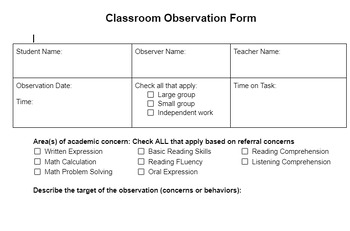
- Google Docs™
Description
Printable form for observing students in the classroom. This helps to make writing the summary of the observation very simple!
Questions & Answers
Fox-lopp creations.
- We're hiring
- Help & FAQ
- Privacy policy
- Student privacy
- Terms of service
- Tell us what you think
Advertisement
The observation of special education classrooms by school personnel
- Original Paper
- Published: 23 March 2021
- Volume 25 , pages 235–253, ( 2022 )
Cite this article
- Christina Cipriano ORCID: orcid.org/0000-0002-7414-1821 1 &
- Tia N. Barnes 2
750 Accesses
1 Altmetric
Explore all metrics
Classroom observation is an accountability practice which promotes the evaluation of teachers’ capacity to meet standards, improve teaching practices, and enhance student learning outcomes. Prior research has revealed that these practices are not without bias: the reliability of observation can be challenged because of classroom or observer characteristics. Unlike general education learning environments, much less is known about the reliability of observing classrooms that service students with disabilities. In this study, we evaluated the reliability of special-education classroom observation by school personnel. Using a systematic scorer design modeled after the MET Project, we examined different combinations of observers (special educator, school leader, paraprofessional, and researcher) and lessons to test the impact of prior exposure to a teacher on scoring the RELATE Tool for Special Education Classroom Observation (RELATE). Analyses of RELATE scorer reliability, comparison of school personnel and researchers on their scores’ aggregates and variance, and the implications for generalization and special education classroom observation are discussed.
This is a preview of subscription content, log in via an institution to check access.
Access this article
Price includes VAT (Russian Federation)
Instant access to the full article PDF.
Rent this article via DeepDyve
Institutional subscriptions
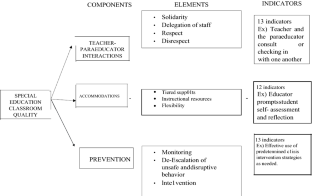
Similar content being viewed by others
The use of cronbach’s alpha when developing and reporting research instruments in science education.
Keith S. Taber

The Impact of Peer Assessment on Academic Performance: A Meta-analysis of Control Group Studies
Kit S. Double, Joshua A. McGrane & Therese N. Hopfenbeck

Ethical Considerations of Conducting Systematic Reviews in Educational Research
Allen, J., Gregory, A., Mikami, A., Lun, J., Hamre, B., & Pianta, R. (2013). Observations of effective teacher–student interactions in secondary school classrooms: Predicting student achievement with the classroom assessment scoring system—Secondary. School Psychology Review, 42 (1), 76–98.
Article Google Scholar
Barnes, T., Cipriano, C., Flynn, L., Rivers, S., & Xu, W. (2019). Validating the Recognizing Excellence in Learning and Teaching (RELATE) Tool for special education classrooms. Journal of Experimental Education, 87 (3), 415–429. https://doi.org/10.1080/00220973.2018.1465383
Bell, C. A., Gitomer, D. H., McCaffrey, D. F., Hamre, B. K., Pianta, R. C., & Qi, Y. (2012). An argument approach to observation protocol validity. Educational Assessment, 17 (2–3), 62–87.
Berger, J. (2014). Word of mouth and interpersonal communication: A review and directions for future research. Journal of Consumer Psychology, 24 (4), 586–607.
Billingsley, B. S. (2004). Special education teacher retention and attrition: A critical analysis of the research literature. The Journal of Special Education, 38, 39–55. https://doi.org/10.1177/00224669040380010401
Borko, H. (2004). Professional development and teacher learning: Mapping the terrain. Educational Researcher, 33 (8), 3–15. https://doi.org/10.3102/0013189X033008003
Brophy, J. (2003). Teaching problem students . Guilford Press.
Google Scholar
Brownell, M. T., & Jones, N. D. (2015). Teacher evaluation in special education: Approaches, supporting research, and challenges confronted. Journal of Special Education Leadership, 28, 63–73.
Bush, G. W. (2001). No child left behind: Executive summary . U.S. Department of Education.
Casabianca, J. M., Lockwood, J. R., & McCaffrey, D. F. (2015). Trends in classroom observation scores. Educational and Psychological Measurement, 75 (2), 311–337.
Cavalier, A. R., Ferretti, R. P., & Hodges, A. E. (1997). Self-management within a classroom token economy for students with learning disabilities. Research in Developmental Disabilities, 18, 167–178. https://doi.org/10.1016/S0891-4222(96)00045-5
Chambers, D. (2015). Working with teaching assistants and other support staff for inclusive education . Emerald Group Publishing Limited.
Book Google Scholar
Chang, L. (1994). A psychometric evaluation of 4-point and 6-point Likert-type scales in relation to reliability and validity. Applied Psychological Measurement, 18, 205–216.
Cicchetti, D. V., Showalter, D., & Tyrer, P. J. (1985). The effect of number of rating scale categories on levels of interater reliability: A Monte Carlo investigation. Applied Psychological Measurement, 9, 31–36.
Cipriano, C., Barnes, T., Bertoli, M., & Rivers, S. (2018). Applicability of the classroom assessment scoring system in special education classrooms serving students with emotional behavioural disorders. Emotional and Behavioural Difficulties, 23 (4), 343–360. https://doi.org/10.1080/13632752.2018.1461454
Clarke, L. S., Embury, D. C., Jones, R. E., & Yssel, N. (2014). Supporting students with disabilities during school crises: A teacher’s guide. Teaching Exceptional Children, 46, 169–178. https://doi.org/10.1177/0040059914534616
Council for Exceptional Children. (2015). What every special educator must know: Professional ethics and standards . Author.
Crowe, C., Rivers, S., & Bertoli, M. (2017). Mind the gap: Accountability, observation, and special education. Assessment in Education: Principles, Policy, and Practice , 24 (1), 21–43. https://doi.org/10.1080/0969594X.2015.1114913
Danielson, C., & McGreal, T. L. (2000). Teacher evaluation to enhance professional practice . Association for Supervision and Curriculum Development.
Danielson, C. (2012). Observing classroom practice . Educational Leadership, 70(3), 32–37.
Desimone, L. M. (2009). Improving impact studies of teachers’ professional development: Toward better conceptualizations and measures. Educational Researcher, 38, 181–199. https://doi.org/10.3102/0013189X08331140
Ferguson, M. (2016). Washington view ESSA as more than the latest acronym on education’s block. Phi Delta Kappan, 97 (6), 72–73. https://doi.org/10.1177/0031721716636879
Ferguson, E., & Cox, T. (1993). Exploratory factor analysis: A users’ guide. International Journal of Selection and Assessment, 1, 84–94. https://doi.org/10.1111/j.1468-2389.1993.tb00092
Fisher, M., & Pleasants, S. L. (2012). Roles, responsibilities, and concerns of paraeducators: Findings from a statewide survey. Remedial and Special Education, 33 (5), 287–297.
Friend, M., Cook, L., Hurley-Chamberlain, D. A., & Shamberger, C. (2010). Coteaching: Anillustrationofthecomplexityofcollaborationinspecialeducation. Journal of Educational and Psychological Consultation, 20 (1), 9e27. https://doi.org/10.1080/10474410903535380
Gabriel, R. (2015). Not whether, but how: Asking the right questions in teacher performance assessment. Language Arts, 93 (2), 120.
Gage, N. A., Lierheimer, K. S., & Goran, L. G. (2012). Characteristics of students with high incidence disabilities broadly defined. Journal of Disability Policy Studies, 23, 168–178. https://doi.org/10.1177/1044207311425385
Gal, E., Schreur, N., & Engel-Yeger, B. (2010). Inclusion of children with disabilities: Teachers’ attitudes and requirements for environmental accommodations. International Journal of Special Education, 25, 89–99.
Ghere, G., & York-Barr, J. (2007). Paraprofessional turnover and retention in inclusive programs: Hidden costs and promising practices. Remedial and Special Education, 28 (1), 21–32.
Giangreco, M. F., Suter, J. C., & Doyle, M. B. (2010). Paraprofessionals in inclusive schools: A review of recent research. Journal of Educational and Psychological Consultation, 20, 41–57. https://doi.org/10.1080/10474410903535356
Hampden-Thompson, G., Diehl, J., & Kinukawa, A. (2007). Description and employment criteria of instructional paraprofessionals (No. NCES 2007-008) . National Center for Educational Statistics.
Haynes, M. (2014). Onthepathtoequity:Improvingtheeffectivenessof beginningteachers . Alliance for Excellent Education.
Hickey, D. T., & Schafer, N. J. (2006). Design-based, participation-centered approaches to classroom management. In C. M. Evertson & C. S. Weinstein (Eds.), Handbook of classroom management: Research, practice, and contemporary issues (pp. 281–308). Lawrence Erlbaum Associates Inc.
Ho, A. D., & Kane, T. J. (2013). The reliability of classroom observations by school personnel . Seattle, WA: Measures of Effective Teaching Project, Bill and Melinda Gates Foundation.
Idol, L. (2006). Toward inclusion of special education students in general education: A program evaluation of eight schools. Remedial and Special Education, 27 (2), 77–94.
Joe, J. N., Tocci, C. M., Holtzman, S. L., & Williams, J. C. (2013). Foundations of observation: Considerations for developing a classroom observation system that helps districts achieve consistent and accurate scores (policy and practice brief) . MET Project, Bill & Melinda Gates Foundation.
Johnson, E. S., & Semmelroth, C. L. (2012). Examining interrater agreement analyses of a pilot special education observation tool. Journal of Special Education Apprenticeship, 1, 1–19.
Jones, N. D. (2015). Using test scores from students with disabilities in teacher evaluation. Educational Measurement: Issues and Practice, 34, 28–38.
Jones, N. D., Brownell, M. T., & Bell, C. (2015). Validating an observation protocol for the evaluation of special educators . Retrieved from https://ies.ed.gov/funding/grantsearch/details.asp?ID=1631 .
Kane, T. J., McCaffrey, D. F., Miller, T., & Staiger, D. O. (2013). Have we identified effective teachers? Validating measures of effective teaching using random assignment (research paper) . MET Project, Bill & Melinda Gates Foundation.
Kane, T. J., & Staiger, D. O. (2012). Gathering feedback for teaching . Seattle, WA: Measures of Effective Teaching Project, Bill and Melinda Gates Foundation.
Lawson, J. E., & Cruz, R. A. (2018). Evaluating special educators’ classroom performance: Does rater “type” matter? Assessment for Effective Intervention, 43 (4), 227–240.
Mastropieri, M. A., & Scruggs, T. E. (2006). The inclusive classroom: Strategies for effective instruction (3rd ed.). Prentice-Hall.
Milanowski, A. (2017). Lower performance evaluation practice ratings for teachers of disadvantaged students: Bias or reflection of reality? AERA Open, 3 (1), 2332858416685550.
National Center for Special Education Research. (2006). Facts from NLTS2: School behavior and disciplinary experiences of youth with disabilities . Retrieved January 4, 2013, from www.nlts2.org/fact_sheets/nlts2_fact_sheet_2006_03.pdf .
National Education Association. (2018). ESP careers: Paraeducators . Retrieved from http://www.nea.org/home/64522.htm .
Newman, L., Wagner, M., Huang, T., Shaver, D., Knokey, A. M., Yu, J., & Cameto, R. (2011a). Secondaryschoolprograms andperformanceof studentswith disabilities:A special topic report of findings from the National Longitudinal Transition Study-2(NLTS2) . National Center for Special Education Research.
Newman, L., Wagner, M., Knokey, A. M., Marder, C., Nagle, K., Shaver, D., & Wei, X. (2011b). The post-high school outcomes of young adults with disabilities up to 8 years after high school: A report from the National Longitudinal Transition Study-2 (NLTS2) (NCSER 2011-3005) . National Center for Special Education Research.
Nichols, A. S., & Sosnowsky, F. L. P. (2002). Burnout among special education teachers in self-contained cross-categorical classrooms. Teacher Education and Special Education, 25 (1), 71–86.
Pianta, R. C., & Hamre, B. K. (2009). Conceptualization, measurement, and improvement of classroom processes: Standardized observation can leverage capacity. Educational Researcher, 38 (2), 109–119. https://doi.org/10.3102/0013189X09332374
Pickett, A. L., Likins, M., & Wallace, T. (2003). The employment and preparation of paraeducators: The state of the art—2003 . Retrieved from http://www.nrcpara.org/sites/default/files/state-of-the-art.pdf .
Reddy, L. A., Fabiano, G. A., & Jimerson, S. R. (2013). Assessment of general education teachers’ Tier 1 classroom practices: Contemporary science, practice, and policy. School Psychology Quarterly, 28 (4), 273.
Ronfeldt, M., Loeb, S., & Wyckoff, J. (2013). How teacher turnover harms student achievement. American Educational Research Journal, 50 (1), 4–36. https://doi.org/10.3102/0002831212463813
Semmelroth, C. L., & Johnson, E. (2014). Measuring rater reliability on a special education observation tool. Assessment for Effective Intervention, 39, 131–145. https://doi.org/10.1177/1534508413511488
Shavelson, R. J., & Webb, N. M. (1991). Generalizability theory: A primer . Sage.
Tabachnick, B. G., & Fidell, L. S. (2007). Using multivariate statistics . Allyn & Bacon/Pearson Education.
Tindal, G., Heath, B., Hollenbeck, K., Almond, P., & Harniss, M. (1998). Accommodating students with disabilities on large-scale tests: An experimental study. Exceptional Children, 64, 439–450. https://doi.org/10.1177/001440299806400401
US Department of Education. (2015). Percentage distribution of students 6 to 21 years old served under Individuals with Disabilities Education Act (IDEA), Part B, by educational environment and type of disability: Selected years, fall 1989 through fall 2013 (Table 204.60) . Retrieved from http://www2.ed.gov/programs/osepidea/618-data/state-leveldatafiles/index.html#bcc
Walsh, S. (2014). What’s happening in DC? UCONN Center for Excellence in Developmental Disabilities . Storrs, CT: Lecture conducted from University of Connecticut, March 2014.
Webber, J., Scheuermann, B., McCall, C., & Coleman, M. (1993). Research on self-monitoring as a behavior management technique in special education classrooms: A descriptive review. Remedial and Special Education, 14, 38–56. https://doi.org/10.1177/074193259301400206
Wragg, T. (2002). An introduction to classroom observation (2nd ed.). Routledge.
Download references
Author information
Authors and affiliations.
Yale Child Study Center, Yale School of Medicine, 350 George Street, New Haven, CT, 06520-8376, USA
Christina Cipriano
Department of Human Development and Family Sciences, University of Delaware, 111 Alison Hall West, Newark, DE, 19716, USA
Tia N. Barnes
You can also search for this author in PubMed Google Scholar
Corresponding author
Correspondence to Christina Cipriano .

Additional information
Publisher's note.
Springer Nature remains neutral with regard to jurisdictional claims in published maps and institutional affiliations.
Rights and permissions
Reprints and permissions
About this article
Cipriano, C., Barnes, T.N. The observation of special education classrooms by school personnel. Learning Environ Res 25 , 235–253 (2022). https://doi.org/10.1007/s10984-021-09359-w
Download citation
Received : 14 February 2020
Accepted : 11 March 2021
Published : 23 March 2021
Issue Date : April 2022
DOI : https://doi.org/10.1007/s10984-021-09359-w
Share this article
Anyone you share the following link with will be able to read this content:
Sorry, a shareable link is not currently available for this article.
Provided by the Springer Nature SharedIt content-sharing initiative
- Classroom observation
- School personnel
- Special education
- Find a journal
- Publish with us
- Track your research

- Resource Room
- Paraprofessionals
- IEP Masterclass
Behavior Observation Forms for Special Education
As the school year ramps up, so do the demands for functional behavioral assessment and special education services. For some teachers, this is a new territory. Behavior observation forms are one way to help gather data and assess behaviors.
What types of special education resources can we use for support?
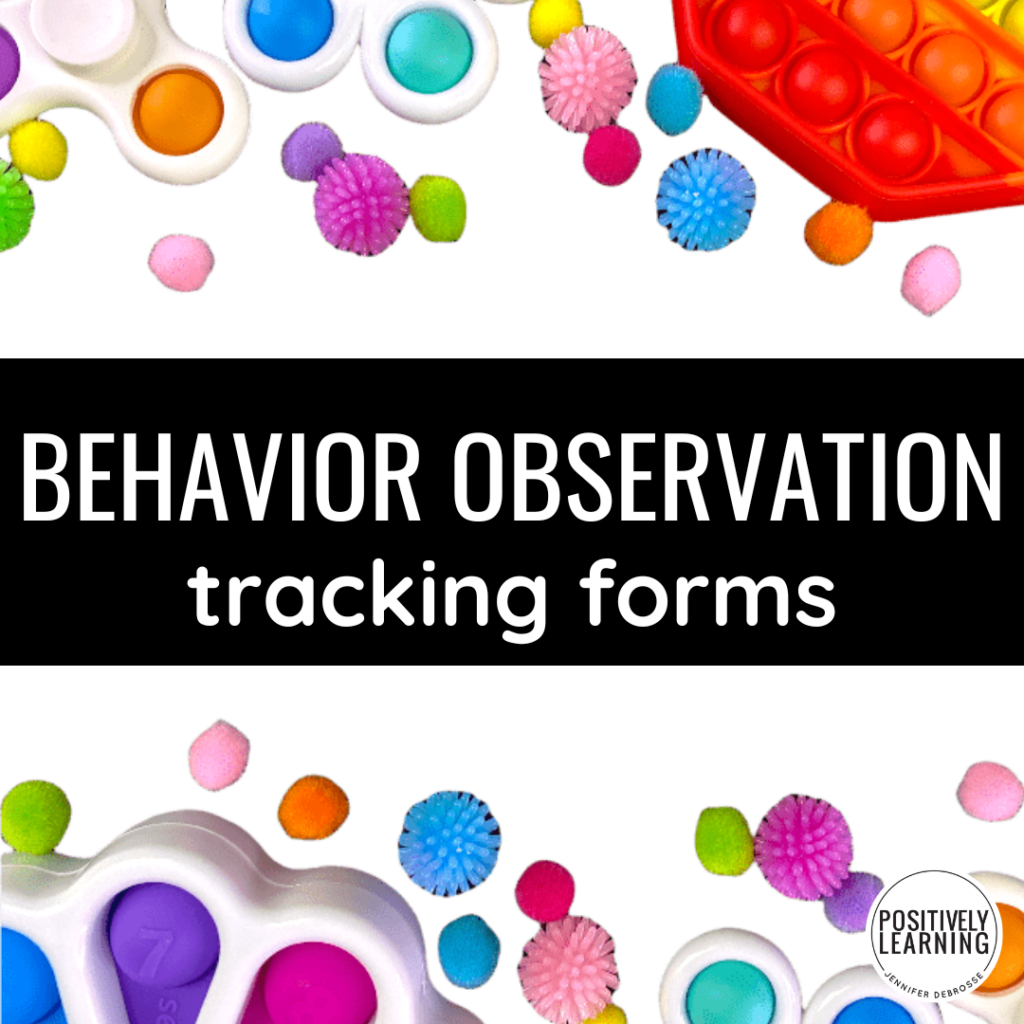
Table of Contents
What are Behavior Observation Forms?
Behavior observation forms are simply a way to collect data on behavior. This can be done in many ways, but the most common is to use an ABC observation or chart. You'll record the Antecedent (what happened before the behavior), the Behavior itself, and the Consequence (what happened after the behavior). Data is usually collected on one specific problem behavior and can be used to create a behavioral intervention plan .
What do you do after the function of the behavior is identified using ABC observations? That's where frequency tracking comes in. This technique is an essential part of any behavior plan, and it can help you determine if the interventions and supports you're using are working or not.
Frequency tracking is a method of data collection that involves counting the number of times a behavior occurs over a period of time. This data can be used to identify patterns and trends in behavior. With a quick glance at frequency tally marks, it's easy to see if the behavior is increasing or decreasing.
Why are Behavior Observation Forms Important?
Behavior observation forms are important because they help to identify patterns in behavior . This is the first step in creating a behavior intervention plan. By understanding when and why a behavior occurs, you can start to put together a behavior plan to address it. This observation data will be key when the IEP team meets to discuss next steps in student support.
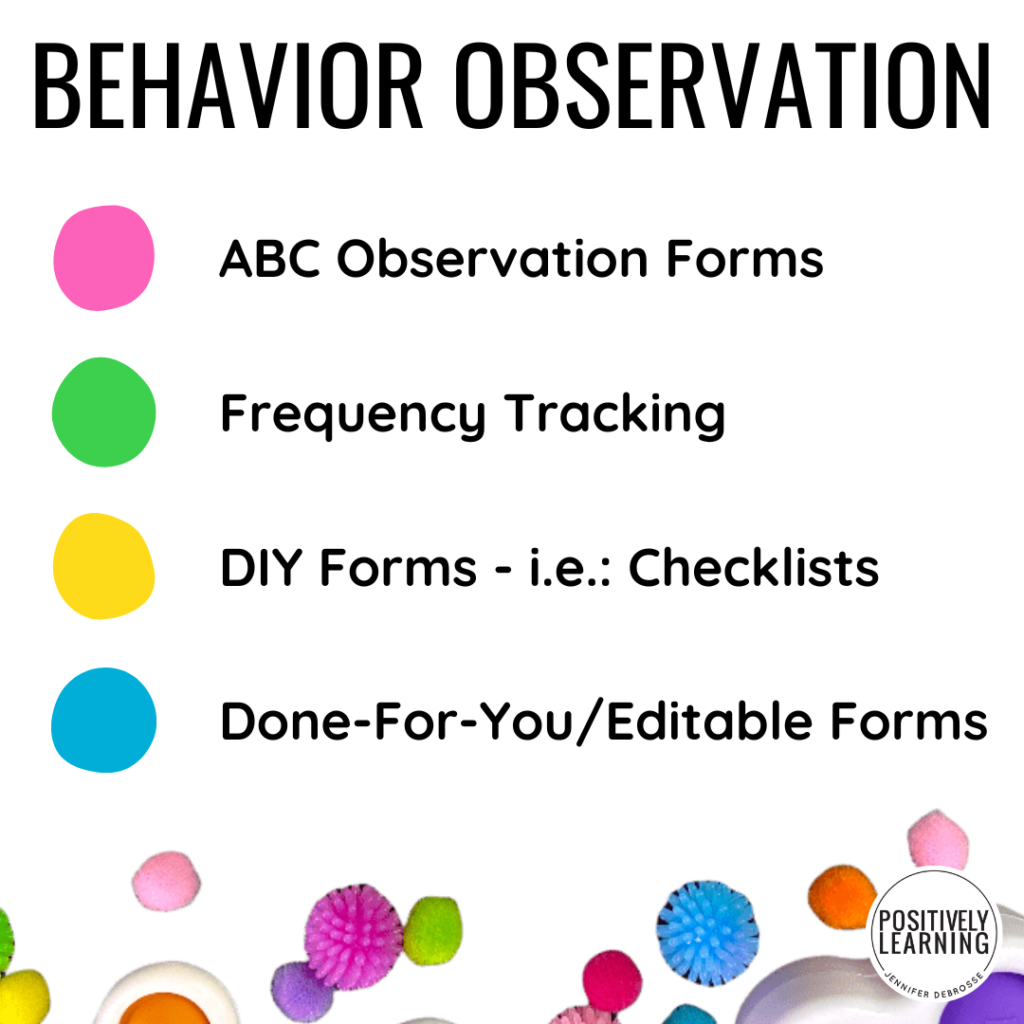
Behavior Observation Options for Special Education Teachers
There are many different ways that you can collect data on behavior.
- You could use something you already have in place, like a behavior observation checklist . This is a simple way to get started and can be easily modified to fit your needs.
- If you're feeling a little more creative, you could design your own behavior observation form . This is a great option if you want to tailor the form to your specific needs.
- If you're looking for a done-for-you option , there are behavior observation forms available for purchase. These are great if you want a professional looking form or don't have the time to design your own. I have 18 easy-to-use behavior supports (including observation forms) ready to go in our Special Educators Resources Bundle .
No matter what route you choose, behavior observation forms are a valuable tool in special education. By taking the time to collect data on behavior, you can start to understand the patterns and develop an effective behavior intervention plan. If you're new to behavior observation forms, there are many different options available to you. Check out this bundle and get started today!
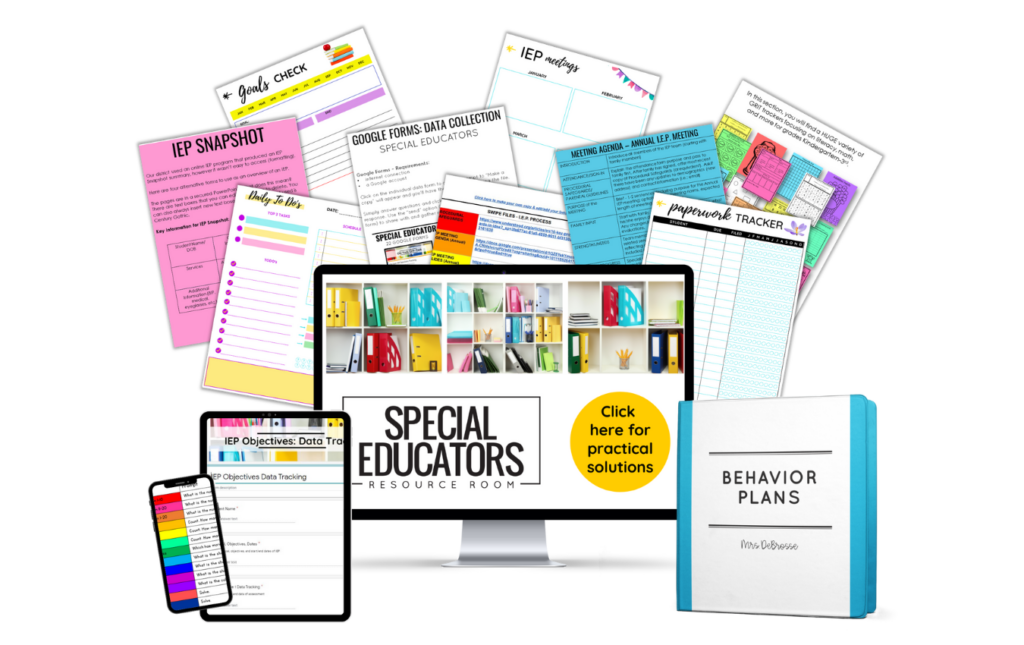
Which option will you start with today?

I'm Jennifer!
I’m Jennifer and I was a special educator in the elementary school setting over the past decade. I entered the classroom every day dedicated to making learning inclusive AND engaging.
On the Blog
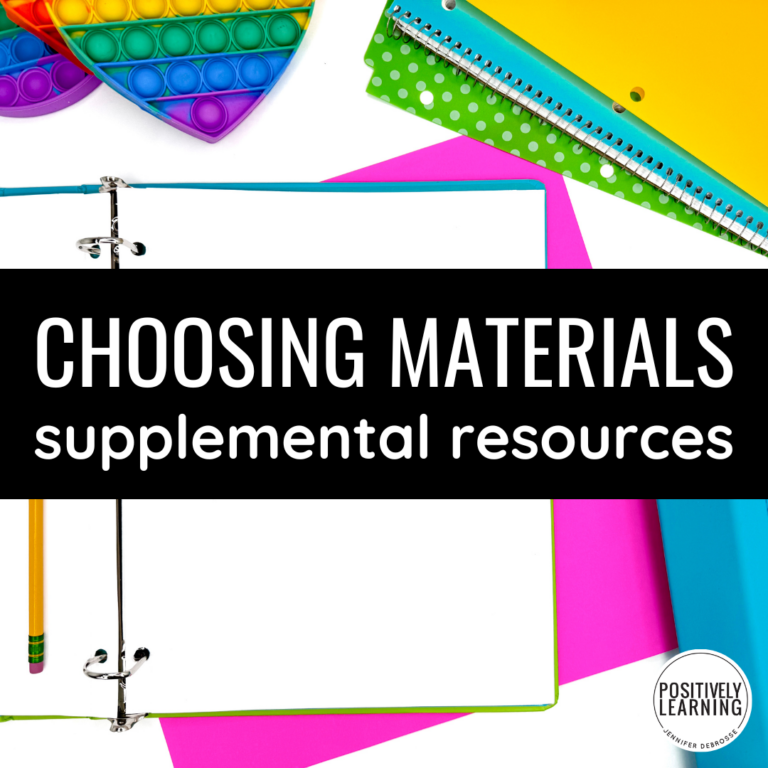
In the Shop
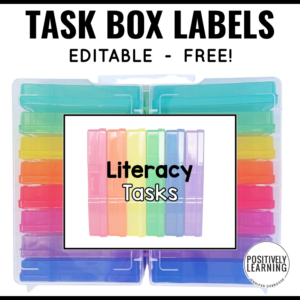
Task Boxes Free Labels for Classroom Organization

IEP Progress Report Card Comments

Classroom Routine Rubrics

- Privacy Policy
- Special Education
- Reading Intervention
- Organization
- More Topics
- Data Collection
- Teacher Gifts
- Shop on TPT
- Free-Sources
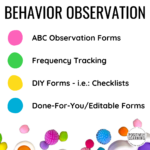
Differentiation delivered to your inbox
This website uses cookies to ensure you get the best experience on our website. See full disclosure here.

- Assistive Technology
- Due Process Calendars
- Evaluation Score Descriptions
- FBA, BIP, & PBSP
- IEP Resources
- Interventions & Accommodations
- Observation Forms
- School Nurse Role
- Transition Planning
NASET.org Home Page
Exceptional teachers teaching exceptional children.
- Overview of NASET
- NASET Leadership
- Directors' Message
- Books by the Executive Directors
- Mission Statement
- NASET Apps for iPhone and iPad
- NASET Store
- NASET Sponsors
- Marketing Opportunities
- Contact NASET
- Renew Your Membership
- Membership Benefits
- Frequently Asked Questions
- Membership Categories
- School / District Membership Information
- Gift Membership
- Membership Benefit for Professors Only
- NASET's Privacy Policy
- Forgot Your User Name or Password?
- Contact Membership Department
- Resources for Special Education Teachers
- Advocacy (Board Certification for Advocacy in Special Education) BCASE
- Board Certification in Special Education
- Inclusion - Board Certification in Inclusion in Special Education (BCISE) Program
- Paraprofessional Skills Preparation Program - PSPP
- Professional Development Program (PDP) Free to NASET Members
- Courses - Professional Development Courses (Free With Membership)
- Forms, Tables, Checklists, and Procedures for Special Education Teachers
- Video and Power Point Library
- IEP Development
- Exceptional Students and Disability Information
- Special Education and the Law
- Transition Services
- Literacy - Teaching Literacy in English to K-5 English Learners
- Facebook - Special Education Teacher Group
- NASET Sponsor's Products and Services
- ADHD Series
- Assessment in Special Education Series
- Autism Spectrum Disorders Series
- Back to School - Special Review
- Bullying of Children
- Classroom Management Series
- Diagnosis of Students with Disabilities and Disorders Series
- Treatment of Disabilities and Disorders for Students Receiving Special Education and Related Services
- Discipline of Students in Special Education Series
- Early Intervention Series
- Genetics in Special Education Series
- How To Series
- Inclusion Series
- IEP Components
- JAASEP - Research Based Journal in Special Education
- Lesser Known Disorders
- NASET NEWS ALERTS
- NASET Q & A Corner
- Parent Teacher Conference Handouts
- The Practical Teacher
- Resolving Disputes with Parents Series
- RTI Roundtable
- Severe Disabilities Series
- Special Educator e-Journal - Latest and Archived Issues
- Week in Review
- Working with Paraprofessionals in Your School
- Author Guidelines for Submission of Manuscripts & Articles to NASET
- SCHOOLS of EXCELLENCE
- Exceptional Charter School in Special Education
- Outstanding Special Education Teacher Award
- Board Certification Programs
- Employers - Job Posting Information
- Latest Job Listings
- Professional Development Program (PDP)
- Employers-Post a Job on NASET
- PDP - Professional Development Courses
- Board Certification in Special Education (BCSE)
- Board Certification in IEP Development (BCIEP)
- NASET Continuing Education/Professional Development Courses
- HONOR SOCIETY - Omega Gamma Chi
- Other Resources for Special Education Teaching Positions
- Highly Qualified Teachers
- Special Education Career Advice
- Special Education Career Fact Sheets
- FAQs for Special Education Teachers
- Special Education Teacher Salaries by State
- State Licensure for Special Education Teachers
- Classroom Management
• Alternate Learning Activities Checklist
• Beginning of School Checklist-Getting to Know Your Students
• Learning Styles Classroom Assessment
• Mainstreaming Checklist
• Multiple Intelligences Inventory
• Possible Occupational Therapy Services Checklist
• Teacher Checklist of Classroom Characteristics
• Writing Disorders Checklist
• Best Practices and Accommodation Procedures for Working with Students with Emotional Disturbance
• Developing Behavior Contracts
If you are a member of NASET , you may access these Checklists and Forms by using the membership login.
If you would like to be a member and access all that NASET has to offer, use this link - JOIN NASET
- Adapting the Curriculum
- Child Development Information
- Child Study Team
- Identification of High Risk Students or Special Needs Students
- IEP (Individual Education Program)
- IEP Committee
- Medical Information
- Related Services Forms
- Suspected Abuse and Neglect
- Working With Parents
- Working with Staff
©2024 National Association of Special Education Teachers. All rights reserved

IMAGES
VIDEO
COMMENTS
Describe the activity/task where student experiences the greatest difficulty. This should be the target of the observation. Student easily locates information and assignments within texts and workbooks without prompts. Student demonstrates ability to function within the provided curriculum without modifications.
• Structured Student Observation Checklist. Forms • Initial Referral to the MDT from the School Staff • Open Ended Referral Form ... • IEP Committee Presentation by the Special Education Teacher as Classroom Teacher • IEP Committee Presentation by the Special Education Teacher as Educational Evaluator
DOMAIN II: STUDENT UNDERSTANDING Standard 3: The teacher assists students in self-regulation and monitors generalization of learning Revised 2/2021 Special Education Observation Form } 4 Indicators 4 • Regularly opens the lesson with a clear introduction and review, model of skills and cognitive strategies, and/or provides clear explanation of concepts, depending on where the teacher is in a ...
National Association of Special Education Teachers NASET | Structured Student Observation Checklist 2 C. At the End of Assigned Time, the Student: _____Completes task _____Takes pride in completed task _____Goes on to next task _____Refuses to complete task SOCIAL INTERACTION The Student:
Easily track and assess the progress of students with special education needs using our free Special Education Student Observation Form. This form allows you to document your observations and assessments of students, providing a comprehensive view of their development and progress. Download it for free and fill it out online, then save it as a ready-to-print PDF.
Department of Special Education Services MONTGOMERY COUNTY PUBLIC SCHOOLS Rockville, Maryland 20850 CLASSROOM OBSERVATION INSTRUCTIONS: This observation should focus on problems identified in the referral. PART II: Setting Describe PART III: Observation PART I: Information Describe the task Describe the student's performance MCPS Form 336-21 ...
The teacher candidate encourages students to be respectful, attentive, and receptive to the ideas of others. Transitions between topics and activities are efficiently and effectively implemented. The teacher candidate utilizes a variety of instructional strategies to meet the needs of diverse learners. The teacher candidate designs instruction ...
Special Education Observation Form ... instruction and/or classroom management for individuals. ___Lesson or activity plan is based on research and student data ___Plan is written concisely and clearly ... Monitored student behavior ___Scanned classroom ___Moved around classroom
If you are a member of NASET, you may access these Checklists, Forms, Tables, and Procedures by using the membership login. If you would like to be a member and access all that NASET has to offer, use this link - JOIN NASET. To top. Special Education Web Site - Teachers Teaching Special Education National Association of Special Education ...
1. ENGAGE AND SUPPORT ALL STUDENTS IN LEARNING Students are actively engaged in learning Students utilize higher order and problem-solving skills Students have opportunity to reflect on their learning SPECIFIC EXAMPLES: 2. CREATE AND MAINTAIN AN EFFECTIVE LEARNING ENVIRONMENT Creates an environment conducive to moral development
Teacher is aware of students' special learning and medical needs. 1c. Setting Instructional Outcomes. Most outcomes represent high expectations and rigor and important learning in the discipline. They are connected to IEP objectives. All the instructional outcomes are clear, and written in the form of student learning.
Special Education Classroom Observation Form—2012 CEC Standards Administration and Purpose. This assessment is administered during the student teaching semester. You will be observed 5-6 times during your student teaching placements by your special education supervisor, who will assess your teaching using this form.
Printable form for observing students in the classroom. This helps to make writing the summary of the observation very simple! Special Education Classroom Observation Form. Rated 5 out of 5, based on 1 reviews. 5.0 ...
validity lens. It is worth noting that Danielson provides scoring supports for observing special education instruction; however, these supports are not designed for special education teachers serving students with high-incidence disabilities (e.g., specific learning disabilities), which is the largest group of SWDs in schools.
amines the role of student observations of faculty teaching, specifically focusing on accessibility in classrooms with diverse students. The observation tool and process that is the focus of this practice brief was implemented as part of the ongoing feed-back loop between students and faculty as part of the professional development project.
Classroom observation is an accountability practice which promotes the evaluation of teachers' capacity to meet standards, improve teaching practices, and enhance student learning outcomes. Prior research has revealed that these practices are not without bias: the reliability of observation can be challenged because of classroom or observer characteristics. Unlike general education learning ...
a how a popular observation system functions for special education teach-ing. There are critical implications for school, district, and state leaders as they consider the impact of these observation systems on students and teachers. Most notably, the findings suggest that special education teachers may not be receiving the type of evidence-based
This Special Education Student Observation Form is great for organizing your notes for the betterment of your kids and the use of your fellow educators, as well as yourself. The observation form asks you to consider where the kid sits in the classroom, with space for you to draw.
This printable template is useful for assessing students in the special education classroom. The observation form asks teachers to consider where the student sits in the space, with room for them to draw a picture. There are also questions referring to the lesson objective, the students engagement, whether they require any additional support and what recommendations/concerns the teacher ...
Behavior observation forms are simply a way to collect data on behavior. This can be done in many ways, but the most common is to use an ABC observation or chart. You'll record the Antecedent (what happened before the behavior), the Behavior itself, and the Consequence (what happened after the behavior).
Bryan Carey - Dean of Students; Christi Sickel - Assistant Director of Special Education; Christa Clark - Special Ed Coordinator; Hannah Helander - Special Ed Coordinator; Amanda Slattery - Special Ed Coordinator; Tina Fredrickson - Assistant Special Ed Director; Chris Hautala - Coordinator of Early Intervening Services
2. AI and EDU updates. Copilot for Microsoft 365 eligibility will be extended to HED students ages 18+ Copilot for Microsoft 365 eligibility will be extended to HED students ages 18+ on April 1st, 2024 for Microsoft or Office 365 A3/A5 users including the Student Use Benefit.. Microsoft Copilot with commercial data protection private preview program for younger learners is starting this spring.
This Special Education Student Observation Form is great for organizing your notes for the betterment of your kids and the use of your fellow educators, as well as yourself. The observation form asks you to consider where the kid sits in the classroom, with space for you to draw.
Checklists. • Alternate Learning Activities Checklist. • Beginning of School Checklist-Getting to Know Your Students. • Learning Styles Classroom Assessment. • Mainstreaming Checklist. • Multiple Intelligences Inventory. • Possible Occupational Therapy Services Checklist. • Teacher Checklist of Classroom Characteristics.